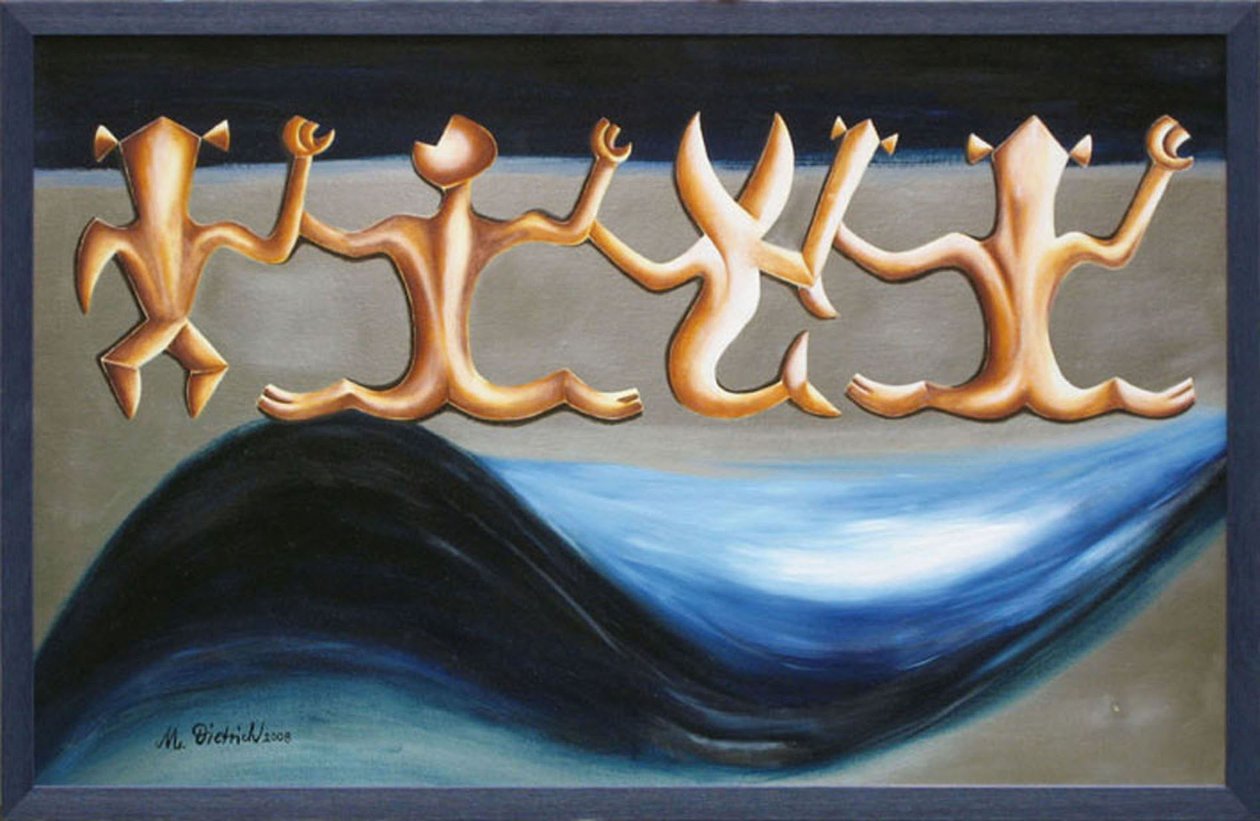2008 · Öl auf Zinnfolie, kaschiert auf mit Leinwand kaschierte HD-Platte
· Picture ID: 857169
Contemporary Arts
Ancestral worship and the resulting cult are the supreme discipline in ethnological research. Such worship has been and still is in all cultures of the world. The cult of ancestor worship was very pronounced in Oceania. The extremely hierarchically structured society remained after death. The common people found themselves again in the Milky Way as one of the countless stars that form the band of the galaxy. High-ranking personalities such as chiefs, initiates in the knowledge, important warriors, shamans etc. were worshiped as Ai-tu after their death. The most commonly used translation is: divine ancestors. This has nothing to do with the cult of canonization in the Catholic Church. After the death of such heroes, those who remained looked for and found a new star in the sky at night. The rebirth of such people was a visible star in the cosmos. The term "personified form" is used in research. The bright star Canopus, which can only be observed from the southern half of the earth, was known under the pictorial idea "he who stands alone". As a man once living, he had so much mana that he stood alone in the sky as Aitu. In any case, the nearest stars are visibly far away from him. Canopus is really alone and without neighbors in the night sky over the South Pacific. There are no stars in the imagination of Polynesian astrologers and astronomers and nothing comparable in the sky at night to our scientific ideas. This explains that the sometimes clearly human figures in the picture are by no means abstract representations of people, but are to be understood as Aitu, as cosmic beings, "visible" as stars. Now the question arises how many such aitu are connected? There are nine of them - but only a specialist who can recognize such relationships through decades of research on the signs can recognize that. The longest ligature is shown in the supposed Easter Island script Rongorongo. Why is the title of the picture supplemented with the English greeting "see you again"? Why is the reunion specifically mentioned here? The supreme discipline in painting is visible when it comes to handling - or "setting", as we painters say - light. Only a few mortals have been given the privilege of setting the light in their pictures as they would have done. This picture alludes to the marginal compass lines. Above is north and thus south below. West is in the picture on the left, which means East can be found on the right in the composition. Ex Oriente lux - the day begins and the Aitu that are only visible at night have to be said goodbye, because they remain invisible to us in the light of the sun. The greeting to the divine ancestors is painted! The light from the east is sophisticated and is only understood by those who "see with their hearts", as the fox explained to the Little Prince. All pictures and sculptures, objects and drawings about the supposed Easter Island script Rongorongo lie on the seam threshold between art and science. After more than 400 years of separation, this is an attempt for the first time to bring together what belonged together in times long past. Who wants to know more about Rongorongo can find it at www.rongorongo-script.de
Aitu - See You Again by Michael H. Dietrich. Available as an art print on canvas, photo paper, watercolor board, uncoated paper or Japanese paper.
easter island ·
polynesia ·
ancestor cult ·
star navigation ·
writing ·
religion ·
seafaring ·
polynesian myths ·
gods of oceania
|
×




.jpg)
_-_(MeisterDrucke-1171263).jpg)
.jpg)
.jpg)
.jpg)
.jpg)
.jpg)
.jpg)
_-_(MeisterDrucke-688603).jpg)
_-_(MeisterDrucke-1171983).jpg)
.jpg)
.jpg)
.jpg)
_-_(MeisterDrucke-1172186).jpg)
_-_(MeisterDrucke-1171973).jpg)
.jpg)
.jpg)
.jpg)
.jpg)
_-_(MeisterDrucke-1464370).jpg)
.jpg)
.jpg)
.jpg)
.jpg)
.jpg)
_-_(MeisterDrucke-1171623).jpg)
_-_(MeisterDrucke-1172211).jpg)
.jpg)
.jpg)
.jpg)
.jpg)
.jpg)
.jpg)
.jpg)
.jpg)
.jpg)
.jpg)
.jpg)
.jpg)
.jpg)
.jpg)
_1929_-_(MeisterDrucke-803243).jpg)
.jpg)
.jpg)







